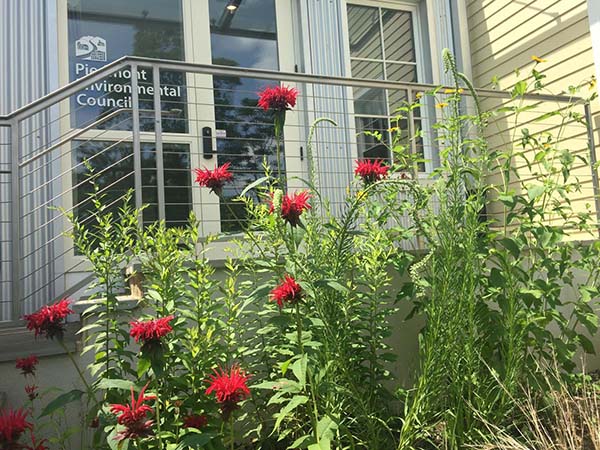If you happen to walk by our office in Old Town Warrenton, you may notice some changes around the building — a little more green, some dashes of color and new trees to boot. And along with it being aesthetically pleasing, it is sustainable.

It has been a year and a half since we finished the renovation of our headquarters office. Soon after we moved back in and unpacked, planning for the restoration of the grounds began.
“Once we completed the building addition, I was anxious to see PEC keep up the momentum and continue with the landscaping. We made such an effort to have the building reflect the organization’s values — from the reuse of an old building, geothermal HVAC system, solar panels, state-of-the art windows and insulation — it was important the landscaping also make a statement that was in keeping with our programmatic goals,” says Doug Larson, former vice president at PEC.
Our office and its surrounding landscape is a demonstration of PEC’s values for a more sustainable future. We want the land to serve as a showcase for future workshops to educate the public on the use of natives to create backyard habitat.
“Completing Doug’s vision of PEC’s headquarters being a demonstration of best practices for sustainable development has been a huge priority,” says Chris Miller, PEC President.
Leading the restoration project is our very own Dan Holmes, director of state policy, who has a background in horticulture and received his masters in landscape design from the Conway School, a graduate program focused on sustainable landscape planning and design.
“What we’re doing on the grounds of the o ce will be an example of what people can do in their own backyard,” says Dan. “The front of the property was designed with the suburban homeowner in mind. Therefore the design is more traditional, mimicking the residential landscapes we have grown accustomed to in the U.S., but we replaced the ornamental European and Asiatic varieties with native plants.
“In the back, we wanted to be a little more wild. So while there is a definite form, we did our best to recreate habitats we find in wilderness. We are also taking a slow approach to recreate woodlands and edge habitat. We are first establishing shade trees (linden and maples) and flowering understory and edible trees (redbud, dogwoods, paw- paw and persimmon) and seeding the area with sun-loving meadow species. Over time, as the shade trees establish, the area will transition and allow for more shade-loving perennials. Thickets of winterberry and smooth sumac extend up from the woodland area, and the landscape transitions to low-growing, shade-loving perennials closer to our back patio.”
Since native plants are supposed to be in our local habitat, they use less and provide more. They require less water, and they don’t need pesticides as the plants have developed their own defenses against local pests. Natives also provide food and shelter to local wildlife, which helps build a stronger ecosystem, and in turn keeps the population of undesirable insects like mosquitoes under control, for example.
One of the first outdoor implementations was the creation of a pollinator garden, spearheaded by our habitat and stewardship specialist, Celia Vuocolo. Some of the plants include scarlet beebalm, blazing star, garden phlox, swamp milkweed and oxeye sunflower. When in bloom, these flowers have been buzzing with pollinators.
“A lot of people think providing wildlife habitat means working on a large scale, but PEC will be able to demonstrate what can be done in a relatively small space,” says Doug. “I think people feel like they can only plant roses or boxwood bushes, and that the other native ‘wild stuff’ is for people who live in a more rural space. But once you see how beautiful the natives are, you realize how great they actually are for smaller urban spaces. And everyone benefits— residents and wildlife.”
PEC board member and long-time supporter of our organization, Mark Ohrstrom, and the founder of Grelen Nursery, Dan Gregg, generously donated many of the plants to our restoration effort.
“We jumped on the opportunity to donate plants to PEC for its native plant garden. Grelen Nursery looks for opportunities to give back to the local community, and this donation was perfect; not only did it help beautify the site, but demonstrates our support for PEC’s mission of protecting open space through conservation and education,” says Dan Gregg.
The restoration of the landscape is still a work in progress, and it will continue to evolve overtime. We are grateful to everyone who has been involved so far and has provided input. We would like to thank Dan Holmes, Chris Miller, Doug Larson, Mark Ohrstrom, Dan Gregg, John McGee, Bruce Jones, Jeannie Perin, Celia Vuocolo, Marco Sanchez and to all of the donors who made this effort possible.
This article was featured in our Summer 2017 Member Newsletter, The Piedmont View.
